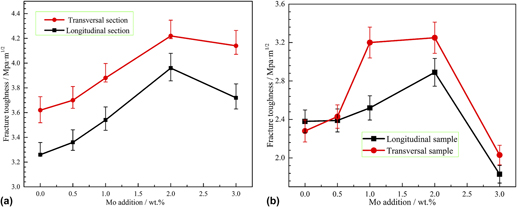Crossref Citations
This article has been cited by the following publications. This list is generated based on data provided by
Crossref.
Jian, Yongxin
Huang, Zhifu
Xing, Jiandong
and
Gao, Yimin
2018.
Effects of chromium on the morphology and mechanical properties of Fe2B intermetallic in Fe-3.0B alloy.
Journal of Materials Science,
Vol. 53,
Issue. 7,
p.
5329.
Li, Kemin
Huang, Zhifu
Zhang, Lei
Wang, Yiran
Shen, Yupeng
He, Lin
Zheng, Qiaoling
and
Li, Hui
2018.
Influence of Cr addition on tribological properties of bulk Fe2B under dry friction and water lubrication.
Materials Research Express,
Vol. 5,
Issue. 7,
p.
076506.
Ling, Zicheng
Chen, Weiping
Lu, Tiwen
Li, Bing
and
Zhang, Xianman
2019.
Interfacial morphology and tribo-corrosion behaviour of Fe-15.3 wt % Cr-3.1 wt % B-6.2 wt % Mo alloy in molten aluminium.
Wear,
Vol. 430-431,
Issue. ,
p.
81.
Li, Kemin
Huang, Zhifu
Wang, Shaofei
Shen, Yupeng
Wang, Wenke
and
Jian, Yongxin
2019.
Effect of oxidation time on the short time oxidation behavior and tribological performance of bulk Fe2B.
Materials Research Express,
Vol. 6,
Issue. 10,
p.
106506.
Zhang, Jianjun
Liu, Jiachen
Liao, Huimin
Zeng, Ming
and
Ma, Sude
2019.
A review on relationship between morphology of boride of Fe-B alloys and the wear/corrosion resistant properties and mechanisms.
Journal of Materials Research and Technology,
Vol. 8,
Issue. 6,
p.
6308.
Jian, Yongxin
Huang, Zhifu
Xing, Jiandong
Sun, Liang
Gao, Yimin
and
Zheng, Qiaoling
2019.
Investigations on the mechanical properties and three-body wear behavior of pure Fe2B intermetallic with different chromium additions.
Wear,
Vol. 418-419,
Issue. ,
p.
273.
Xu, Gaopeng
Wang, Kui
Dong, Xianping
Yang, Lei
Jiang, Haiyan
Wang, Qudong
and
Ding, Wenjiang
2020.
Effects of Titanium Addition on the Microstructural and Mechanical Property Evolution of FeCrB Alloys.
Metallurgical and Materials Transactions A,
Vol. 51,
Issue. 9,
p.
4610.
Otto, Johannes L.
Penyaz, Milena
Schmiedt-Kalenborn, Anke
Knyazeva, Marina
Ivannikov, Alexander
Kalin, Boris
and
Walther, Frank
2020.
Effect of phase formation due to holding time of vacuum brazed AISI 304L/NiCrSiB joints on corrosion fatigue properties.
Journal of Materials Research and Technology,
Vol. 9,
Issue. 5,
p.
10550.
Chen, Zhiguo
Miao, Sen
Kong, Lingnan
Wei, Xiang
Zhang, Feihong
and
Yu, Hongbin
2020.
Effect of Mo Concentration on the Microstructure Evolution and Properties of High Boron Cast Steel.
Materials,
Vol. 13,
Issue. 4,
p.
975.
Jian, Yongxin
Huang, Zhifu
Wang, Yu
Wu, Tonghai
and
Xing, Jiandong
2021.
Solidification process, microstructure, and mechanical properties of Cr-doped high boron Fe-based alloy.
Materials Chemistry and Physics,
Vol. 267,
Issue. ,
p.
124592.
Wang, Guangchi
Jiang, Yehua
Li, Zulai
Chong, Xiaoyu
and
Feng, Jing
2021.
Balance between strength and ductility of dilute Fe2B by high-throughput first-principles calculations.
Ceramics International,
Vol. 47,
Issue. 4,
p.
4758.
Ma, Teng
Yin, Yunyu
Hong, Fang
Zhu, Pinwen
and
Yu, Xiaohui
2021.
Magnetic, Electronic, and Mechanical Properties of Bulk ε-Fe2N Synthesized at High Pressures.
ACS Omega,
Vol. 6,
Issue. 19,
p.
12591.
Jian, Yongxin
Ning, Haiyue
Huang, Zhifu
Wang, Yu
and
Xing, Jiandong
2021.
Three-body abrasive wear behaviors and mechanism analysis of Fe–B–C cast alloys with various Mn contents.
Journal of Materials Research and Technology,
Vol. 14,
Issue. ,
p.
1301.
Chen, Zhiguo
Zhang, Feihong
and
Wei, Xiang
2021.
Effect of Mo concentration on structural, mechanical, electronic and magnetic properties of Fe2B: a first-principles study.
Philosophical Magazine,
Vol. 101,
Issue. 13,
p.
1549.
Wang, Guangchi
Chong, Xiaoyu
Li, Zulai
Feng, Jing
and
Jiang, Yehua
2022.
Design of Fe2B-based ductile high temperature ceramics: First-principles calculations and experimental validation.
Ceramics International,
Vol. 48,
Issue. 18,
p.
27163.
Wei, Xiang
Chen, Zhiguo
Mao, Hong
Peng, Guangwei
Liu, Baogang
and
Wu, Jiwen
2023.
First‐principles study on stability, Debye temperature, mechanical, electronic and magnetic properties of Fe2B compounds.
International Journal of Quantum Chemistry,
Vol. 123,
Issue. 10,
Wang, Guangchi
Chong, Xiaoyu
Li, Zulai
Feng, Jing
and
Jiang, Yehua
2024.
Strain-stiffening of chemical bonding enhance strength and fracture toughness of the interface of Fe2B/Fe in situ composite.
Materials Characterization,
Vol. 207,
Issue. ,
p.
113575.






